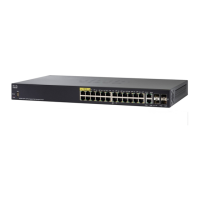Quality of Service (QoS) Commands
935 Cisco Sx350 Ph. 2.2.5 Devices - Command Line Interface Reference Guide
47
Syntax
qos aggregate-policer
aggregate-policer-name
committed-rate-kbps
committed-burst-byte
[exceed-action
action
] [peak
peak-rate-kbps
peak-burst-byte
[violate-action
action
]]
no qos aggregate-policer
aggregate-policer-name
Parameters
•
aggregate-policer-name
—Specifies the aggregate policer name. (Length:
1–32 characters)
•
committed-rate-kbps
—Specifies the average traffic rate (CIR) in kbits per
second (bps).(Range: 3–57982058)
•
committed-burst-byte
—Specifies the normal burst size (CBS) in bytes.
(Range: 3000–19173960)
• exceed-action—Specifies the action taken when the committed rate is
exceeded and the peak rate is not exceeded. If the keyword is not
configured then the following action is applied:
- drop, if peak the keyword is not configured.
- policed-dscp-transmit, if peak the keyword is configured.
• peak—Specifies the Two-rate Three-color policer. If the peak rate is
exceeded the packet is dropped.
•
peak-rate-kbps
—Specifies the average traffic rate (CIR) in kbits per second
(bps).(Range: 3–57982058)
•
peak-burst-byte
—Specifies the peak burst size (PBS) in bytes. (Range:
3000–19173960)
• violate-action—Specifies the action taken when the peak rate is exceeded.
If the keyword is not configured then the drop action is applied.
•
action
—Specifies the taken action. The possible values are:
- drop—Drops the packet.
- policed-dscp-transmit—Remarks the packet DSCP of IP traffic. The
DSCP remarking is configured by the qos map policed-dscp command
with the violation keyword for the violation action and without this
keyword for the exceed action. DSCP remarking will have effect only if
the mode is trust dscp.

